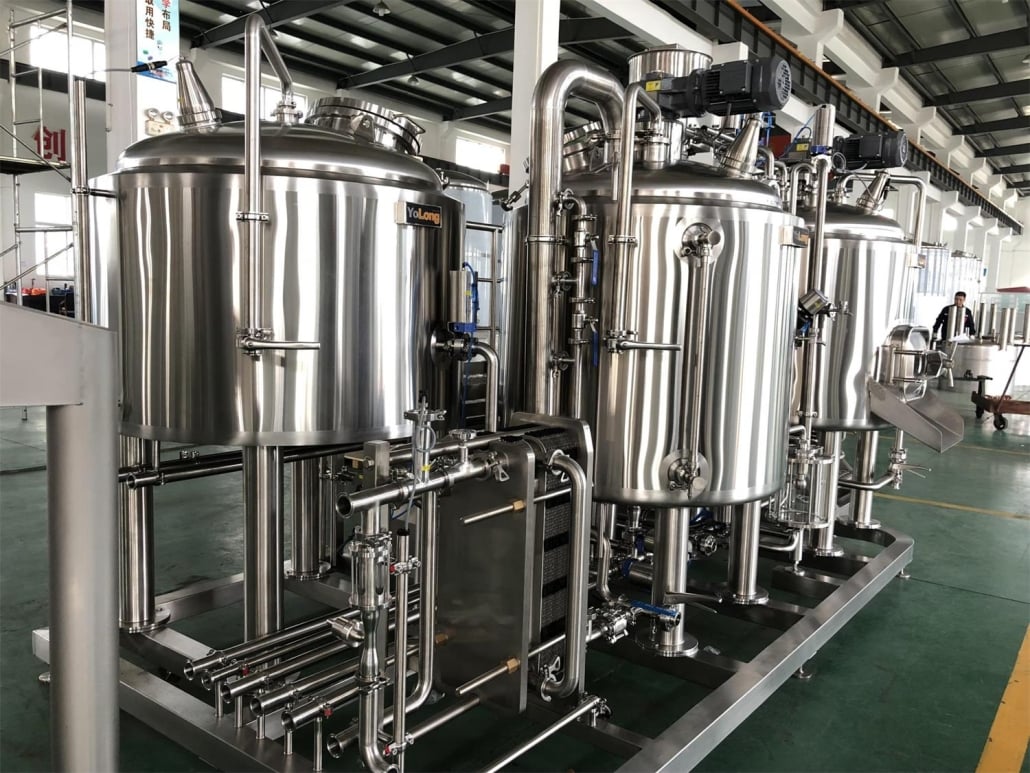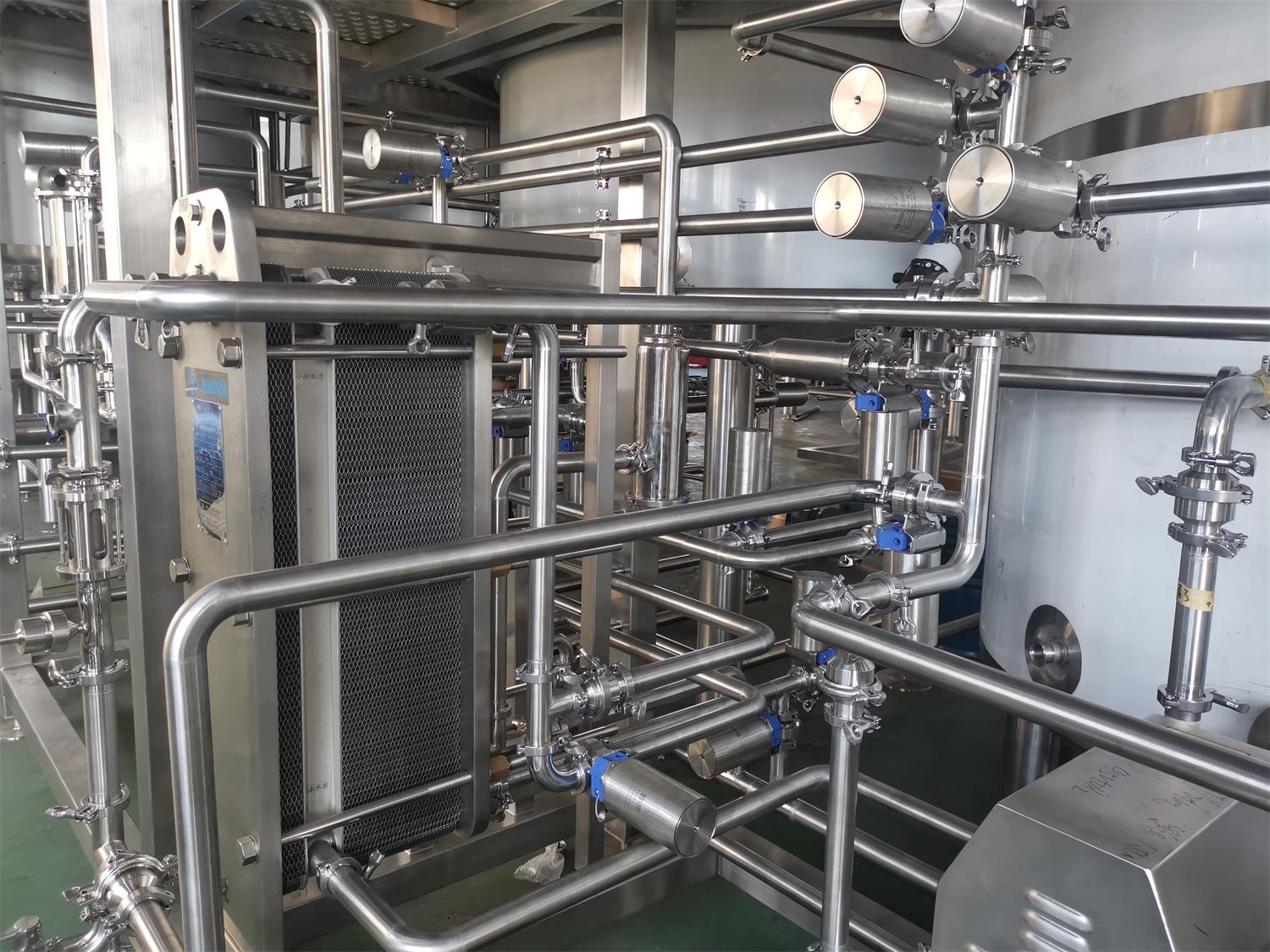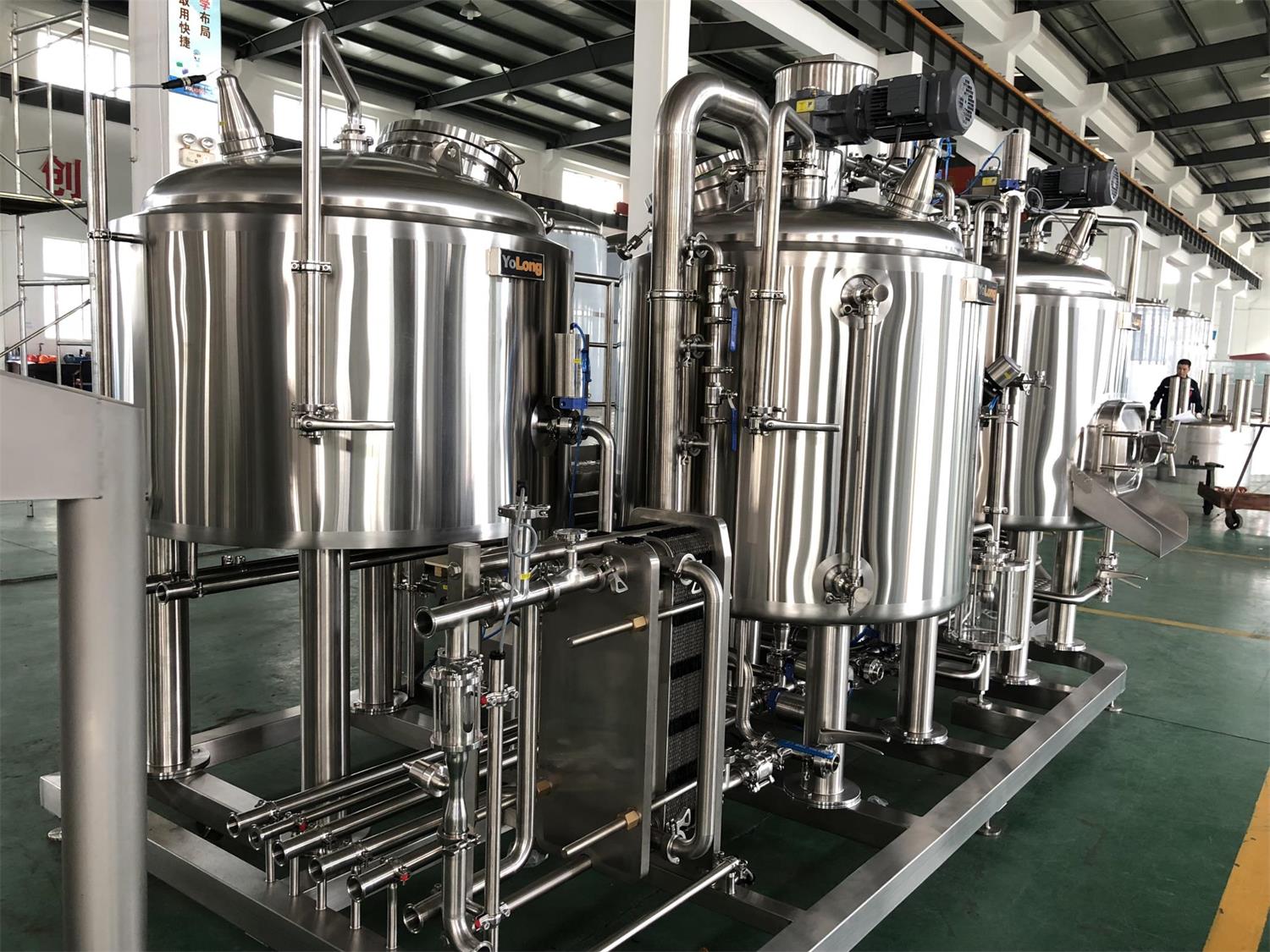What Type of Heat Exchanger is Best For My Brewery?
Plate heat exchanger is used to lower or raise the temperature of the beer liquid or wort as part of the beer making process. Because this equipment is fabricated as a series of plates, it can be referred to a heat exchanger or PHE.
During wort cooling, Heat exchangers must be related to the capacity of the brewing system, And PHE must have the capacity to cool a kettle batch down to fermentation temperature levels in around three quarters of an hour or less.
So, What Type of Heat Exchanger is Best For My Brewery?
There are many types of plate heat exchangers for wort cooling. Choosing a suitable plate heat exchanger can not only save a lot of energy consumption caused by refrigeration, but also control the temperature of wort very conveniently.
There are currently two options for plate heat exchangers for wort cooling: one is a single-stage plate heat exchanger. The second is Two-Stage.
- single-stage plate heat exchanger
- The single-stage plate heat exchanger uses only one cooling medium to cool the wort, which saves many pipes and valves and reduces the cost.
- The internal structure is simple, and the price is relatively cheap.
- The cooling media used in single-stage plate heat exchangers are:
- 20°C tap water: This medium cools the wort to around 26°C, suitable for high fermentation temperature beers: A
- 3°C cold water: This medium can cool the wort to about 12°C, which can meet the fermentation temperature of most beers, but to prepare cold water, it is necessary to configure an ice water tank with 1-1.5 times the volume of the wort, and prepare cold water at the same time need to consume a lot of energy.
- -4°C Glycol water: This medium can cool the wort to any temperature required for beer fermentation, but the temperature of Glycol water will rise to about 15-20°C after heat exchange, which will affect the temperature control of fermentation. At the same time, it will consume a lot of energy.

2.Double-stage plate heat exchanger
- The double-stage-plate heat exchanger uses two cooling media to cool the wort, which has many pipes and relatively high cost.
- The internal structure of this type of plate heat exchanger is complex, and the price is about 30% higher than that of a single stage.
- The cooling medium combinations used in the double-stage cold plate heat exchanger are:
- 20°C tap water & -4°C Glycol water: This combination method can cool the wort to any fermentation temperature, and the treated tap water can be heated to 80°C after heat exchange. Glycol water is heated to 3~5°C after heat exchange. If brewing ale, do not cool with Glycol water.
- 3°C cold water & -4°C Glycol water: This combination method can cool the wort to any fermentation temperature, but it consumes a lot of energy and needs to be equipped with a separate cold water tank.
- -4°C Glycol water: This medium can cool the wort to any temperature required for beer fermentation, but the temperature of Glycol water will rise to about 15-20°C after heat exchange, which will affect the temperature control of fermentation. At the same time, it will consume a lot of energy.
- 20°C tap water & 3°C cold water: This combination can cool the wort to any fermentation temperature. However, it is also necessary to configure a cold water tank with 0.5 times the volume of wort. High energy consumption for preparing cold water.

To sum up, for craft breweries below the 3T/Per brewing system, we highly recommend configuring two-stage wort cooling plate heat exchangers and use a combination of 20°C tap water & -4°C Glycol water. It is the best choice in terms of energy consumption and process control of brewing temperature control.
Meanwhile,Plate heat exchangers are used in many areas of the brewery to heat up and cool down the beer liquid and also to chill/heat water. Heat exchangers are used in many food production processes where flash pasteurization is required. In a brewery, the beer is heated up quickly to pasteurize it, then it is held for a short period as it makes the journey through a network of pipes. Following this, the beer liquid temperature is rapidly decreased before it undergoes the next production stage.
Frequently Asked Questions (FAQ)
1) How do I size a plate heat exchanger (PHE) for my Brewery wort cooling?
- Base it on brewhouse volume, knockout time (target ≤45 minutes), wort inlet temp (~98–100°C), target outlet (8–20°C by yeast/ale-lager), and cooling media temps/flows. Vendors size by required heat load in kW = m·Cp·ΔT and plate surface area.
2) Single-stage vs two-stage: which is more energy efficient?
- Two-stage (e.g., 20°C tap water pre-cool + -4°C glycol finish) is typically most efficient because it recovers hot water for the next mash and minimizes glycol duty, lowering chiller load and operating cost.
3) What hot liquor recovery should I expect from wort cooling?
- With 20°C tap water as Stage 1, expect 65–80°C outlet water suitable for mash-in/cleaning, often yielding 0.8–1.2 L of hot liquor per liter of wort cooled, depending on flows and plate area.
4) How do I control oxygen pickup and contamination through the PHE?
- Sanitary design with pre-knockout sanitation (CIP + hot water or steam), sterile gas blankets on the cold side, sanitary gaskets, low-oxygen deaerated liquor for dilution, and verified differential pressures to prevent cross-leakage.
5) What maintenance schedule extends PHE life?
- After each brew: rinse and caustic/acid CIP; weekly: backflush; quarterly: plate inspection, gasket check, differential pressure trending; annually: pull-and-inspect, replace gaskets as needed, perform pressure test. Follow 3-A/EHEDG-aligned hygienic practices.
2025 Industry Trends for Brewery Heat Exchangers
- Energy recovery first: widespread adoption of two-stage cooling with automated hot liquor recovery and conductivity-based water reuse.
- Low-oxygen brewing: DAW (deaerated water) loops paired with PHEs to keep knockout DO <10 ppb for lagers.
- Fouling-aware controls: inline turbidity and differential pressure sensors trigger automated backflush/CIP, improving consistency.
- Compact gasket materials: longer-life elastomers (EPDM/FKM blends) rated for higher temperatures/chemistries, reducing downtime.
- Pasteurization precision: more craft breweries using plate or tubular HX skids with validated PU targets for shelf-stable SKUs.
Wort Cooling & Energy Benchmarks (2024–2025)
| Metric | Typical Range | 2025 Best Practice Target | Notes / Sources |
|---|---|---|---|
| Knockout time per batch | 35–60 min | ≤45 min | Sized PHE + proper flows |
| Hot liquor recovery temp | 60–75°C | 70–80°C | Two-stage with tap water |
| Glycol temperature rise across Stage 2 | 2–6°C | 2–4°C | Right plate area/flow |
| Knockout DO (ppb) | 10–50 | ≤10 (lagers), ≤30 (ales) | ASBC methods |
| Chiller energy reduction vs single-stage | — | 15–30% savings | Vendor case studies/BA guides |
| CIP time per cycle | 30–60 min | 25–40 min with auto-sequences | Conductivity/time/temp control |
Authoritative references:
- Brewers Association energy/water best practices: https://www.brewersassociation.org/
- ASBC Methods of Analysis (DO, microbiology): https://www.asbcnet.org/
- EHEDG hygienic heat exchanger guidance: https://www.ehedg.org/
Latest Research Cases
Case Study 1: Two-Stage PHE + DAW Knockout for Lagers (2025)
Background: A 20 hL Brewery reported variable lager stability and high glycol loads during summer.
Solution: Installed two-stage PHE using 20°C tap water (Stage 1) and -3°C glycol (Stage 2) plus a deaerated water skid for dilution and pre-rinse; added inline DO meter at knockout.
Results: Knockout DO reduced from 28–35 ppb to 6–9 ppb; chiller kWh on brew days down 22%; hot liquor recovery at 74–77°C covered 95% of next mash-in water.
Case Study 2: Fouling Monitoring Cuts CIP Downtime (2024)
Background: Plate fouling from adjunct-heavy mashes caused longer knockout and inconsistent temps.
Solution: Implemented differential pressure sensors across PHE and auto-backflush logic triggered by ΔP thresholds; quarterly plate pull-and-inspect SOP.
Results: Median knockout time improved from 56 to 41 minutes; unplanned PHE downtime down 70%; chemical use reduced 18% per CIP cycle.
Expert Opinions
- Dr. Tom Shellhammer, Professor of Fermentation Science, Oregon State University
“Two-stage cooling with effective hot liquor recovery improves thermal economics while protecting flavor stability—especially when paired with low-oxygen practices.” - John Mallett, Brewing operations expert; author of “Malt”
“Size the PHE for your peak knockout conditions, not average. Adequate plate area and balanced flows beat chasing problems with the chiller.” - Ashton Lewis, Technical Support Director, BSG
“Monitor differential pressure and DO at knockout. These two numbers tell you most of what you need about fouling, leaks, and oxygen control.”
Practical Tools/Resources
- BA Energy Star-like calculators and water recovery guides: https://www.brewersassociation.org/
- ASBC DO measurement protocols for knockout verification: https://www.asbcnet.org/
- EHEDG guidance on hygienic heat exchangers: https://www.ehedg.org/
- Vendor selection/sizing tools (e.g., Alfa Laval, GEA, SPX Flow) for PHE area and plate geometry
- Low-oxygen brewing community resources and DAW design notes (Brewers’ forums, supplier app notes)
Last updated: 2025-08-29
Changelog: Added 5-item FAQ, 2025 trends with performance benchmarks table, two recent case studies on two-stage cooling and fouling control, expert opinions, and practical resources relevant to Brewery heat exchanger selection and operation.
Next review date & triggers: 2026-02-28 or earlier if BA/EHEDG publish updated HX guidance, new gasket/plate materials show >10% efficiency gains, or internal knockout DO exceeds targets for two consecutive months.
Share this entry
Interested in learning more about Brewing Systems including additional details and pricing information? Please use the form below to contact us!
YOLONG BREWERY EQUIPMENT FAQS
- Commercial Brewery / Craft Brewery / Microbrewery / Nanobrewery
- What is The Difference Between Craft Beer and Industrial Beer?
- The Bespoke Differences In Custom Brewing Systems
- Everything You Need to Know About Kettle Souring
- How to Choose Brewing Equipment for Your business?
- How To Choose The-Best Partner To Build Your Commercial Microbrewing System?
- Two Detection Sensors That You Need To Use In Your Brewhouse System
- Remote Control Applications in Brewing Equipment/How does it work?
- How To Clean Your Brand New Brewery Tanks?

